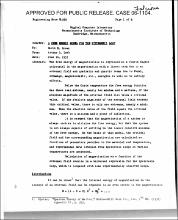A Free Energy Model For The Hysteresis Loop
Loeb, Arthur L.

DownloadMC665_r04_E-559.pdf (1.911Mb)
Date
1953-06-16Abstract
The free energy of magnetization is expressed as a fourth degree polynomial in the magnetization with a linear term due to an external field and quadratic and quartic terms due to Fermi, exchange, magnetostatic, etc., energies as well as to entropy effects.
Below the Curie temperature the free energy function has three real extrema, namely two minima and a maximum, if the absolute magnitude of the external field lies below a critical value. If the absolute magnitude of the external field exceeds this critical value, there is only one extremum, namely a minimum. When the absolute value of the field equals the critical value, there is a minimum and a point of inflection.
It is assumed that the magnetization of a system is always such as to minimize the free energy, but that the system is not always capable of settling in the lowest relative minimum of the free energy. On the basis of this model, the critical field and the corresponding magnetization are calculated as functions of parameters peculiar to the material and temperature, and experimental data obtained from hysteresis loops at various temperatures are presented.
Calculation of magnetization as a function of the external field results in a universal expression for the hysteresis loop, which is compared with some experimentally observed loops.